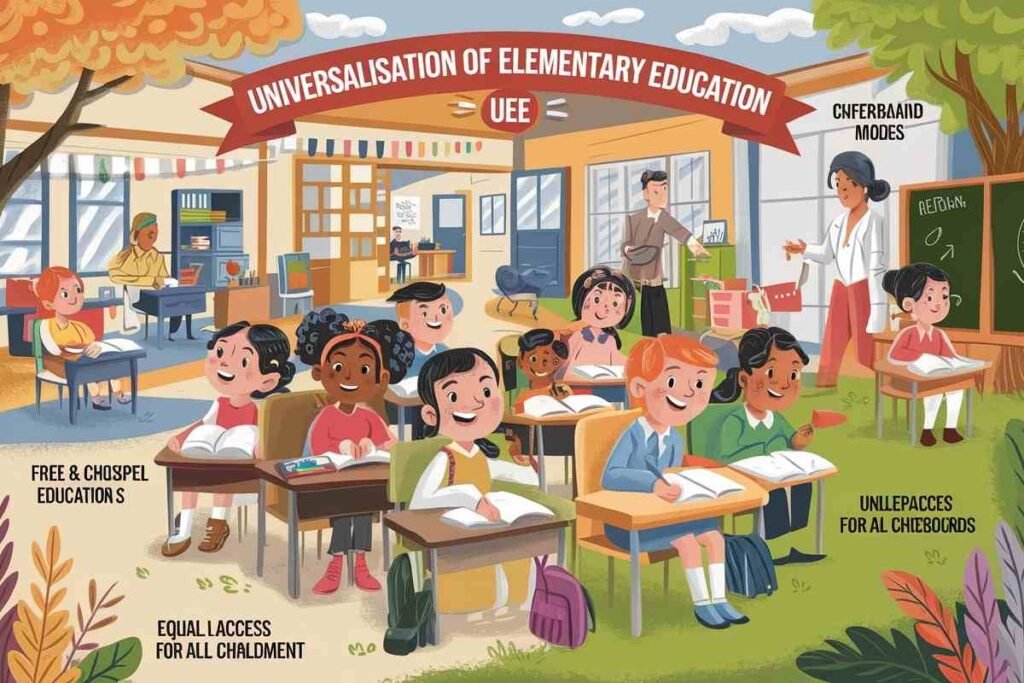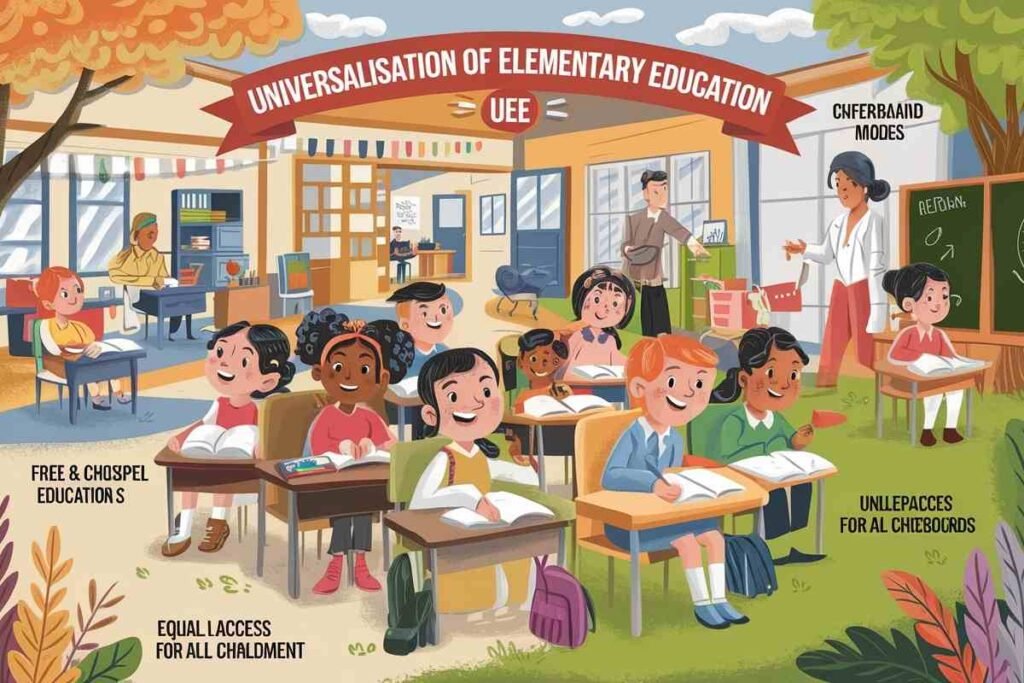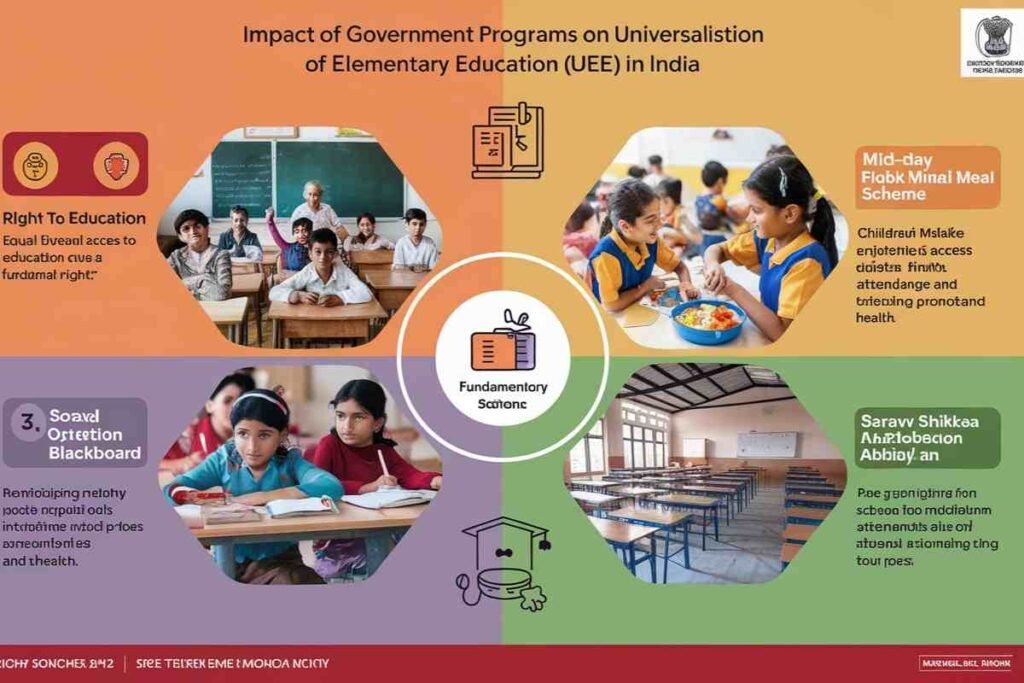The Universalisation of Elementary Education (UEE) is a pivotal goal that aims to ensure every child, regardless of socio-economic background, access to quality education up to the elementary level.
This initiative is integral to national and international educational policies, playing a crucial role in human capital development and contributing to the achievement of the Sustainable Development Goals (SDGs).In India, UEE is closely linked with Universalization of Primary Education (UPE), a movement that has made substantial progress over the years.
This article will provide a detailed Universalisation of Elementary Education understanding of UEE, its stages, importance, challenges, strategies for achieving it, and how various government programs contribute to its success. It will also serve as essential B.Ed notes to help students grasp the significance of these concepts in the context of the Indian education system.
What is Universalisation of Elementary Education (UEE)?

The Universalization of Elementary Education refers to the commitment to providing free and compulsory education to all children from the age of 6 to 14 years, covering grades 1 to 8.
In India, this commitment is enshrined in Article 21A of the Constitution, making elementary education a fundamental right for all children.
The objective is not only to ensure universal enrolment but also to improve retention, achievement levels, and overall educational quality.
Stages of Universalisation of Elementary Education
The process of Universalization of Elementary Education has evolved through several stages in India:
- Pre-Independence Stage: Before India’s independence, education was not universally accessible. The focus was on the elite, with limited access for the rural and marginalized populations.
- Post-Independence Stage: Following independence in 1947, India focused on universalizing education as part of its developmental agenda. Initiatives like the National Policy on Education (NPE) were introduced to provide education to all children, with an emphasis on improving literacy rates.
- The Right to Education (RTE) Act Stage: The RTE Act, 2009, marked a major milestone in the Universalization of Elementary Education by making education free and compulsory for all children in the 6 to 14 age group. The act focuses on improving school infrastructure, teaching quality, and access to education for marginalized groups.
- Contemporary Stage: This stage involves implementing reforms based on community-based planning, teacher development, inclusive education, and technological integration to address existing challenges and ensure that no child is left behind.
Key Components of Universalisation of Elementary Education (UEE)
The following four components form the foundation of UEE:
- Universal Provision of Schools: Ensuring that every child has access to a nearby school with the required infrastructure.
- Universal Enrolment: Ensuring that all children, especially those from disadvantaged communities (like Scheduled Castes (SC), Scheduled Tribes (ST), and girls), are enrolled in school.
- Universal Retention: Ensuring that children not only enroll but remain in school until they complete elementary education.
- Universal Achievement: Ensuring that children achieve satisfactory learning outcomes, acquiring the necessary skills and knowledge.
The Role of Education in National Development
The Universalization of Education is fundamental for the development of any nation, and UEE plays a central role in India’s growth in the following ways:
- Economic Development: Quality elementary education leads to enhanced human capital, improving economic productivity, and creating better employment opportunities.
- Social Development: Education fosters social equity and cohesion, promoting inclusivity and reducing disparities, particularly for marginalized groups.
- Empowerment of Women: Educating girls is key to achieving gender equality, improving their social status, and fostering economic growth within communities.
Key Strategies for Achieving Universalisation of Elementary Education

To achieve UEE, India has adopted a multi-pronged approach that addresses both supply and demand challenges. Key strategies include:
- Improving School Infrastructure: Ensuring that every child has access to well-equipped schools with clean drinking water, sanitation facilities, and teaching materials. Programs like Operation Blackboard focus on basic infrastructure in rural areas.
- Focusing on Teacher Quality: Improving teacher education and providing professional development are essential for achieving quality education. Teachers must be equipped to handle mixed-age classrooms and diverse learners, particularly in rural settings.
- Financial Incentives and Support: The government provides free textbooks, uniforms, mid-day meals, and scholarships to reduce economic barriers and increase enrollment and retention, particularly among girls and disadvantaged communities.
- Community Involvement: Micro-planning and School Mapping involve local communities in identifying specific educational needs, improving school management, and making education more relevant to the local context.
- Enhancing Curriculum and Pedagogy: Reforming the curriculum to make it more child-friendly and contextually relevant is key to improving retention rates and reducing the academic burden on students.
Challenges in Achieving Universalisation of Elementary Education
Despite substantial progress, several challenges persist in achieving UEE in India:
- Gender Disparity: In many rural areas, girls face barriers such as early marriage and domestic responsibilities, leading to higher dropout rates and lower retention.
- Economic Barriers: Poverty forces many children to drop out of school, as they are needed to work and contribute to the family income.
- Quality of Education: While enrollment rates have improved, the quality of education remains subpar in many areas due to poor infrastructure, a lack of trained teachers, and outdated curricula.
- Cultural and Linguistic Barriers: The diversity of languages and cultures in India presents challenges in delivering standardized education.
Impact of Government Programs on Universalization of Elementary Education

Several government programs have made significant strides in promoting UEE:
- The Right to Education (RTE) Act, 2009: Ensures free and compulsory education for children between 6 and 14 years of age.
- Mid-Day Meal Scheme: Aims to improve nutrition and encourage school attendance by providing free meals.
- Operation Blackboard: Provides basic teaching facilities like blackboards and furniture to schools, particularly in rural areas.
- Sarva Shiksha Abhiyan (SSA): A flagship program aimed at improving school infrastructure, teacher training, and ensuring quality education.
Role of Micro Planning and School Mapping in UEE
School Mapping and Micro Planning are crucial tools in identifying educational gaps and improving access to education.
School Mapping involves analyzing existing school infrastructure to identify areas requiring new schools or improvements.
Micro Planning ensures that local educational needs are met through community-based planning, making the education system more contextually relevant.
Conclusion
The Universalization of Elementary Education is a vital component of India’s educational policy. By addressing key challenges and leveraging strategies like improving infrastructure, enhancing teacher quality, and promoting community involvement, India can ensure that every child receives quality education.
Programs like RTE, Operation Blackboard, and SSA have laid a strong foundation, and continuous efforts from the government and communities will ensure the success of UEE, leading to a brighter and more equitable future for all children.
For B.Ed students, understanding these components, challenges, and strategies is crucial to becoming effective educators and contributing to the vision of Universalization of Education in India.
FAQS
What is the Universalisation of Elementary Education (UEE)?
UEE is the commitment to provide free and compulsory education to all children aged 6-14 years in India, ensuring access to quality education up to the elementary level.
What is the main goal of the Right to Education (RTE) Act?
The RTE Act ensures that every child between 6 and 14 years old has the right to free and compulsory education, making education a fundamental right.
How does the Mid-Day Meal Scheme support education?
The Mid-Day Meal Scheme provides free meals to children in schools, aiming to improve nutrition, encourage regular attendance, and reduce dropout rates.
What is Operation Blackboard?
Operation Blackboard is a government initiative aimed at improving basic school infrastructure, including providing blackboards, furniture, and teaching materials, especially in rural schools.
How does Sarva Shiksha Abhiyan (SSA) contribute to UEE?
SSA focuses on improving school infrastructure, teacher training, and providing quality education, especially in rural and remote areas, to achieve the goals of UEE.
What are the main challenges in achieving Universalisation of Elementary Education?
Challenges include gender disparities, economic barriers, poor quality of education, and cultural and linguistic diversity that can affect access to education for all children.
Why is teacher quality important for Universalisation of Elementary Education?
Teachers play a key role in ensuring effective learning outcomes. Improving teacher education and training is essential to provide quality education and reduce dropout rates.
How can community involvement help in achieving UEE?
Community involvement through micro-planning and school mapping ensures that education is more relevant to local needs, helping to address barriers and improve access to schools.